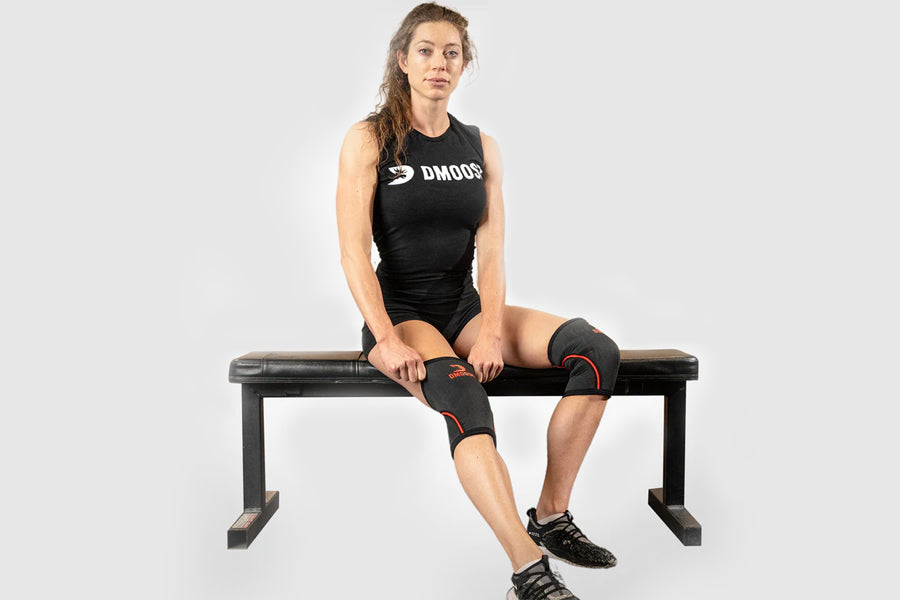Are you tired of knee sleeves that roll down or are too tight? Do you feel you're missing out on the benefits of proper knee support during weightlifting? Fear not! The solution may be as simple as measuring the right knee sleeve size.
Yes, measuring can be daunting, but don't worry - we've got your back (well, your knees, actually). In this sizing guide, we'll walk you through the steps on how to accurately measure your knees and determine the perfect size for your knee sleeves. So, get ready to lift like a pro with the right support without the hassle of ill-fitting knee sleeves.
What Are Knee Sleeves?

Knee sleeves for weightlifting and powerlifting are compression garments designed to provide support, stability, and warmth for your knees during weightlifting exercises. They are usually made from neoprene, polyester, and sometimes cotton. The fabric is designed to form-fit to the contours of your leg while providing just enough compression to improve blood flow and reduce muscle fatigue.
Knee sleeves are vital equipment for weightlifters, providing support and stability to the knees during intense training sessions. Measuring your knees accurately is crucial to ensure you get the right fit and maximize knee sleeves' benefits. This sizing guide will walk you through the step-by-step process of measuring for knee sleeves, helping you find the perfect fit for your weightlifting needs.
"Wearing knee sleeves is the best way to prevent injuries and keep your legs feeling strong." ~ Dwayne Johnson (Actor, Professional Wrestler)
Related Article: Knee Sleeves for Squats: Everything You Need to Know
Why Should You Wear Knee Sleeves?
Knee sleeves can help you get more out of each lift by providing additional support to the knee joint. This helps minimize strain on the area's muscles and ligaments while reducing the risk of injury due to repetitive motion or overexertion.
Before diving into the measuring process, it's essential to understand why properly fitted knee sleeves are crucial for weightlifting. Knee sleeves offer several benefits, including:
Joint Support

Knee sleeves are an excellent accessory to add to your workout gear bag. These sleeves offer extra support to any athlete or fitness enthusiast looking to protect their knees from injury or discomfort.
They are perfect for individuals who engage in high-impact activities like running, jumping, or weightlifting. Knee sleeves are designed to provide compression and heat retention, which helps to stimulate blood flow and improve circulation.
This ultimately leads to better joint support and reduced inflammation, making it easier for athletes to push themselves farther than ever before.
For added joint support, you can also invest in the DMoose Compression Knee Sleeve for Joint Support. These knee sleeves are highly recommended as they offer ultimate support, firmness, enhance blood flow, and more. Prevent future injuries while investing in these knee sleeves!
Increased Blood Flow
Knee sleeves are an essential accessory for fitness enthusiasts looking to take their exercise routine up a notch. Aside from providing support and stability to the knee joint, one of the main benefits of knee sleeves is their increased blood flow.
During exercise, the muscles in the legs and knees require ample oxygen and nutrients to perform optimally and recover quickly. Knee sleeves help increase blood flow to these muscles, supplying them with the necessary nutrients and oxygen to work tirelessly.
The result is increased endurance, faster recovery times, and improved performance. So, to enhance your exercise routine, consider the power of knee sleeves and their ability to boost blood flow.
Warmth and Comfort
Knee sleeves may seem like a small accessory for your workout, but their benefits are not overlooked. One significant benefit of wearing knee sleeves during exercise is their added warmth. This can be especially helpful during colder seasons or when working out outside. Overall, knee sleeves are a small investment that can significantly enhance your workout experience while keeping your knees happy and healthy.
Performance Enhancement
Knee sleeves are a seemingly simple piece of equipment that can significantly impact athletic performance. They can improve blood flow and flexibility, leading to enhanced performance. Additionally, knee sleeves can reduce the risk of injury by protecting against scrapes and bumps.
Factors to Choose While Buying the Knee Sleeves
When choosing knee sleeves, there are a few essential factors to remember. A properly-fitted knee sleeve should be snug around the knee without slipping or bunching and should not restrict movement or cause discomfort. Here are the key factors to consider:
Size and Fit
Choose the correct size based on your knee circumference and length measurements. Ensure a snug fit that provides compression and support without being overly tight or restrictive. Check the manufacturer's size chart and recommendations for accurate sizing.
Material Quality
Look for knee sleeves made from high-quality materials that are durable and can withstand the demands of weightlifting. Consider materials that offer balance support, flexibility, and breathability, such as neoprene or a blend of materials.
Compression Level
Determine the level of compression you prefer. Thicker knee sleeves provide more compression and stability, while thinner sleeves offer greater flexibility and mobility. Consider the specific needs of your weightlifting routine and choose a compression level that aligns with your goals.
Sleeve Thickness
Decide on the appropriate thickness of the knee sleeve based on your preferences and requirements. Thicker sleeves (5mm to 7mm) offer maximum support and compression, suitable for heavy lifting or individuals with knee issues. Thinner sleeves (3mm to 4mm) provide moderate support while allowing for more flexibility, ideal for activities that require a more comprehensive range of motion.
Design and Construction
Look for knee sleeves with reinforced stitching and quality construction for durability and longevity. Consider additional features like silicone grippers or anti-slip bands to keep the sleeves securely in place during workouts.
Brand Reputation and Reviews
Research different brands and their reputation for producing high-quality knee sleeves. Read customer reviews and feedback to gauge knee sleeves' performance, comfort, and durability.
Price and Budget
Determine your budget range and compare the price points of different knee sleeves.
Keep in mind that higher-priced knee sleeves often reflect better quality and durability, but there are also affordable options that provide adequate support.
Purpose and Intended Use
Consider your specific weightlifting goals and the type of exercises you'll be performing.
Determine if you need knee sleeves primarily for support, injury prevention, or enhanced performance during heavy lifts. By considering these factors and evaluating your needs, you can make an informed decision when purchasing knee sleeves that best suit your weightlifting requirements.
Step-By-Step Measurement Process
Before starting the measurement process, gather the following tools: Flexible measuring tape, Pen, and paper to note down measurements. Follow these steps to measure for knee sleeves accurately:
Step 1: Prepare for Measurement
Before measuring your knees, make sure you are standing upright with your legs slightly apart and relaxed. Ensure your knees are not locked, and keep the measuring tape handy.
Step 2: Measuring the Circumference of the Knee
Take the flexible measuring tape and wrap it around the midpoint of your knee joint. The tape should be snug but not too tight. Ensure the tape is parallel to the ground, and note the measurement in inches or centimeters.
Step 3: Measuring the Length of the Knee
Next, measure the length of your knee joint. Start from the top of the kneecap (patella) and measure down to the base of the kneecap. Ensure the measuring tape follows the curve of the kneecap. Note the length in inches or centimeters.
Step 4: Determine Sleeve Thickness and Size Chart
After measuring your knee circumference and length, it's time to determine the appropriate sleeve thickness and consult a size chart. The sleeve thickness is a personal preference based on the level of support and mobility you desire.
Typically, thicker knee sleeves (5mm to 7mm) provide maximum support and compression, making them ideal for heavy lifting or individuals with knee issues. Thinner sleeves (3mm to 4mm) offer moderate support while allowing for a greater range of motion, suitable for more flexible activities.
Refer to the manufacturer's size chart to find the corresponding knee sleeve size based on your measurements. Each brand may have slightly different sizing guidelines, so it's essential to consult the specific size chart provided by the manufacturer.
Step 5: Choosing the Right Size

Using your knee circumference and length measurements, locate the corresponding size on the manufacturer's chart. If your measurements fall between two sizes, choosing the larger size is generally recommended for a more comfortable fit. However, opt for the smaller size if you prefer a tighter compression.
Remember that knee sleeves should fit snugly but be tight enough. They should provide compression and support without causing discomfort or restricting blood flow.
Should I Choose a 5MM Knee Sleeve or a 7MM Knee Sleeve?
Choosing between a 5mm knee sleeve and a 7mm knee sleeve depends on your specific needs and preferences. Here are some factors to consider:
Support and Stability
Generally, a thicker knee sleeve provides more support and stability to the knee joint. If you have a history of knee injuries, require extra stability during heavy lifting or intense physical activities, or participate in sports that put significant stress on your knees, a 7mm knee sleeve may be more suitable.
Flexibility and Range of Motion
Thinner knee sleeves, like the 5mm option, allow for more flexibility and a wider range of motion. If you engage in activities requiring greater knee mobility, such as running, jumping, or agility-based sports, the 5mm knee sleeve may be a better choice.
Comfort
Thicker knee sleeves may feel bulkier and tighter due to the extra material, which can be uncomfortable for some individuals. Thinner knee sleeves often offer a more comfortable and less restrictive fit. Consider your comfort preferences when making your decision.
Injury or Recovery Status
If you're currently recovering from a knee injury or have ongoing knee pain, it's advisable to consult with a healthcare professional or physical therapist. They can assess your condition and recommend the appropriate knee sleeve thickness to support recovery and prevent further injury.
Ultimately, choosing a knee sleeve that suits your needs and provides the right balance of support, comfort, and mobility is essential. Try both thicknesses if possible and see which one feels more comfortable and supportive for your specific activities.
FAQs
1. How tight should my knee sleeve be?
Your knee sleeve should not feel uncomfortable or too tight, but it should be snug enough so that you can freely move without any pain or discomfort.
2. Can I wear a smaller size if the correct size feels too loose?
No. A smaller size may not provide adequate support and cause further damage or discomfort due to a lack of proper fit.
3. Can I wear a larger size if the correct size feels too tight?
The purpose of knee sleeves is to provide compression and support to the joint. So, if you choose a larger pair of knee sleeves that is too loose, it can't effectively provide these benefits. In short, it's best to stick to the correct size for optimal performance and protection.
4. How often should I replace my knee sleeve?
Depending on your use, we recommend replacing your knee sleeve every 6-12 months for optimal performance and support. If you notice any signs of wear or tear sooner than this, then it is time to replace it immediately.
Conclusion
Properly fitted knee sleeves are essential for weightlifters to enhance performance, provide support, and minimize the risk of injuries. Following the step-by-step measurement process outlined in this guide and considering individual preferences, you can find the perfect knee sleeves for your weightlifting needs.
Consider the manufacturer's size chart and the desired sleeve thickness. With the fitting knee sleeves, you can optimize your weightlifting sessions and protect your knees for long-term success.











